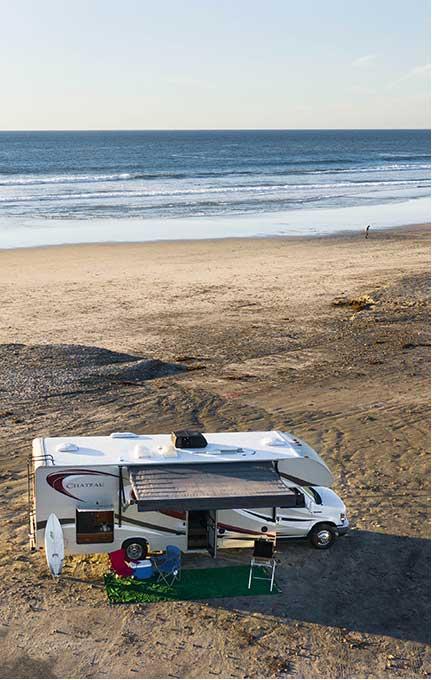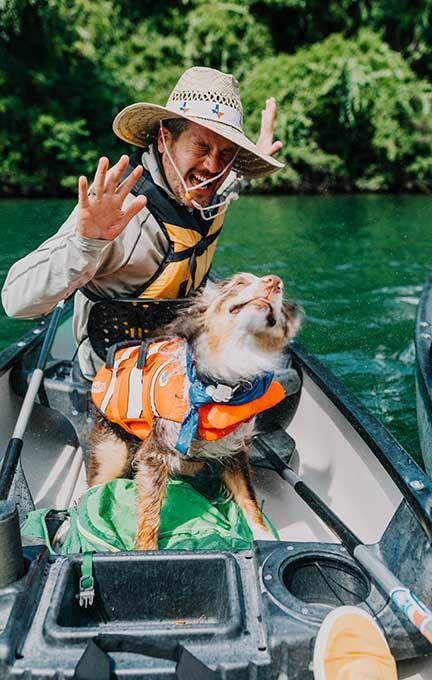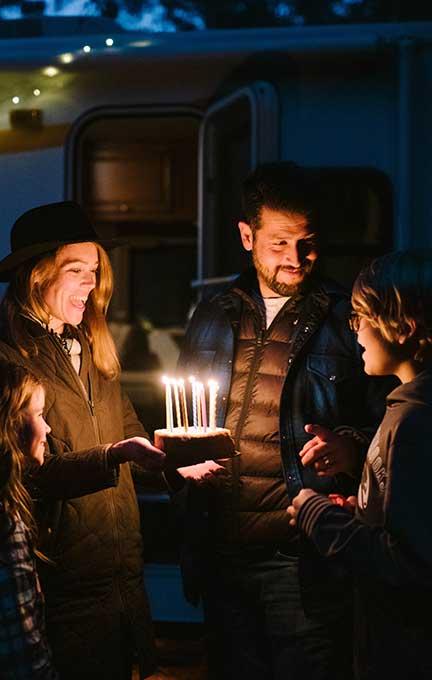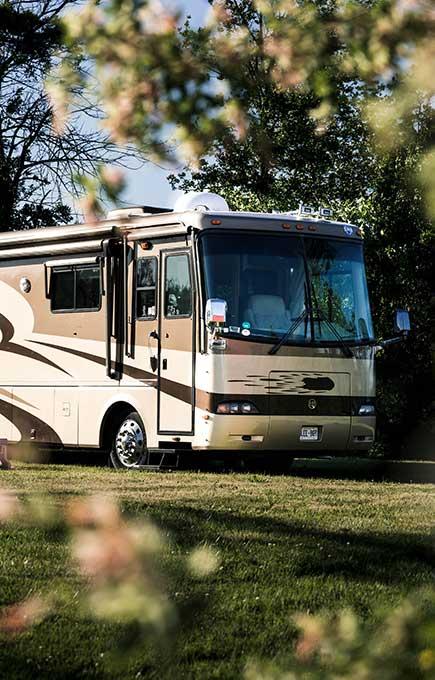Summer isn’t the only time of year that’s great for RV trips! Who doesn’t need a good vacation after the busy holiday season? If you’re searching for a great getaway, we have the perfect winter RV destinations for you. Whether you’re looking for warmer weather or want to enjoy ski season, winter RVing has something for everyone.
In this article, we’ll share some of our favorite winter spots, as well as some helpful hints for picking out the right RV for the trip. Buckle up!
Best Winter RV Destinations
1. Tucson, Arizona
Arizona as a whole is a great place to RV in the winter. You can drive all over the state and enjoy a variety of winter activities. You can head to Flagstaff for great skiing and see the Grand Canyon covered in snow, then return to the desert to thaw out. Campers especially love the Tucson area during the winter months. The average daily temperature there in January is comfy 66 degrees!
Tucson has a charming downtown to explore and you can also take a drive through beautiful Saguaro National Park. Nearby, you’ll find desert vibes and beautiful sunsets at Picacho Peak State Park. This park offers beautiful hikes and is conveniently located about 30 minutes from Tucson. Head there in February to enjoy Spring Training and witness the beautiful wildflower season and see the flowers on the saguaros bloom!
Video source: Visit Tucson
2. Austin, Texas
If you love good music and food, you’ll love Austin. This vibrant and eclectic city is booming right now. Average daily temperatures stay in the 60s all winter making it a great warm weather spot. Plus, there is SO much more to do than just eat, drink, and dance. Lake Travis and Lady Bird Lake offer various water activities like kayaking and canoeing. Nearby McKinney Falls State Park has great campsites and hiking trails. Of course, you can always take a day trip to Texas wine country and visit the beautiful vineyards of Fredericksburg, TX.

3. The Florida Keys
Okay, this one is a given. The Keys have always been the ultimate snowbird destination. If you’d rather be sitting on white sandy beaches and watching beautiful sunsets than skiing or snowshoeing, then head to the Florida Keys this winter! There are tons of state parks that offer beach-front camping, as well as many RV resorts that have all the amenities you’d want for a relaxing vacation. Be sure to visit each Key, as they all offer their own unique subcultures.
The Fiesta Key RV Resort has 28 acres of ocean views, full-hookup sites, and it’s centrally located. From this resort you can take a day trip to Miami, explore Everglades National Park, or even head further south to the other keys. There’s also plenty of hiking, snorkeling, and swimming to do right next door in Long Key State Park.
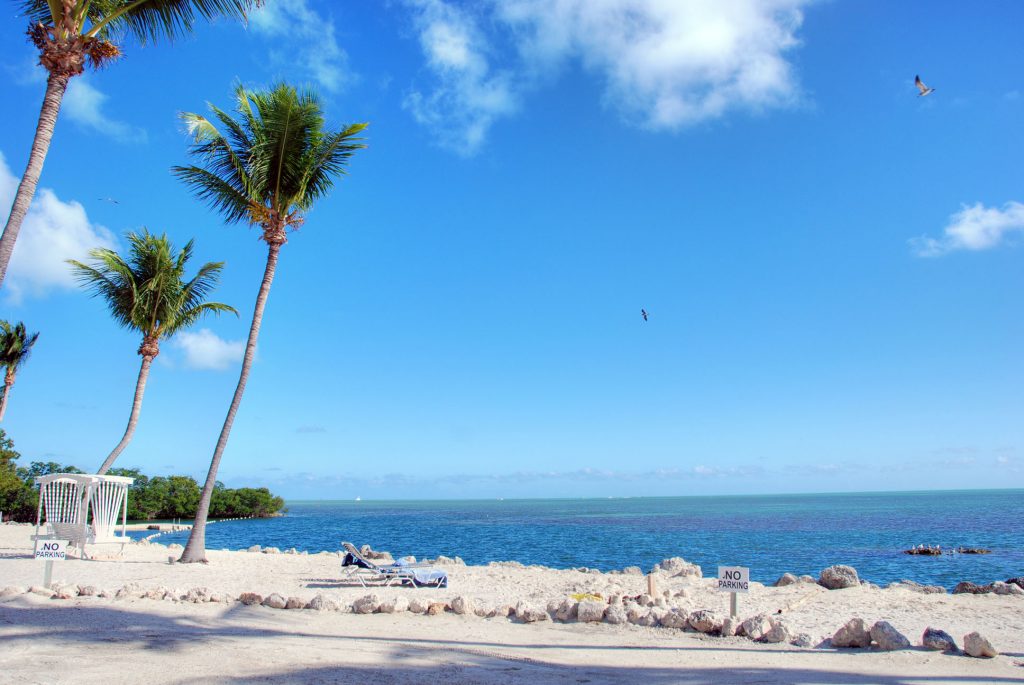
4. Southern California
There’s a reason California has the highest population in the U.S. The winters are mild and the beaches are beautiful and accessible all year long. Nearly every stop along the coast between San Diego and Los Angeles is a great RV destination. We loved Dana Point and parking our RV steps from the beach at Doheney State Beach. There are also great whale-watching opportunities in the winter off the coast of Southern California!

5. Everglades National Park, Florida
Mild temperatures, less humidity, and far fewer crowds make the Everglades a great national park to visit in the winter. One of the biggest draws to the Everglades is its optimal wildlife viewing. You’re sure to see crocodiles and alligators along with the white-tailed deer that love the winter because of the lower water levels.

6. Big Bend National Park, Texas
Big Bend National Park is perhaps most appealing in winter when temperatures stay in the 60s during the daytime. This weather is perfect for hiking and biking the 200 miles of trails that the park offers. Big Bend offers the best of both mountain and desert terrain and with the Rio Grande River bordering the park, you can also take part in water activities!

7. Breckenridge, Colorado
Finding an RV park near one of the nation’s most well-known ski resorts is rare! But Tiger Run RV Resort makes Breckenridge an incredible winter RV destination. Aside from the skiing, Breckenridge is one of Colorado’s most popular mountain towns because of its charming downtown, beautiful scenery, and a wide array of outdoor activities. Breckenridge is also a short drive from Vail, Keystone, and Copper, which are all other popular Colorado ski towns. Do you hear that? The mountains are calling and you better go!

8. Jackson Hole, Wyoming
The majestic Teton Range combined with some of the best skiing in the nation makes Jackson Hole the perfect winter wonderland destination. Jackson Hole Campground offers year-round camping and is only 5 minutes from the ski resort. If you’re not a skier, then perhaps you’d enjoy dog sledding tours, snowmobiling, snow tubing, gondola rides, or snowshoeing. Jackson Hole also offers a variety of dining and shopping options, as well as many spas. And don’t forget about the nearby national parks: Grand Teton and Yellowstone!

Best Types of RVs for Winter Camping
Have some good winter RV destinations in mind? If you’re going camping in the cooler months, there are a few more things that you should take into consideration when picking out your RV rental.
Even if you’re headed to warmer weather, there are some important things to keep in mind. Remember that while daytime temperatures may hover in the 60s, the nighttime can bring cooler air at many of these destinations. Especially if you’re camping in desert regions, be prepared for some pretty chilly nights.
Pop-Up Campers
Pop-up campers are a great option for people who want a step up from tent camping but aren’t looking to haul around a big rig. Getting up off the ground will help you stay a lot warmer, and you can most likely take care of your basic needs without going outside. While it won’t slip into your backpack, a pop-up camper is light, easily towed, and fits in small campsites.
On the downside, those canvas walls don’t provide a whole lot of insulation when those winter winds blow. These are best for areas like South Florida, where the nighttime temperatures won’t dip too far.
Travel Trailers

Towable trailers, often just called travel trailers, are an upgrade from the pop-up and provide great protection from the elements. They are budget-friendly and come in a wide variety of shapes, sizes, and designs. Because there are so many to choose from, you can pick one that fits your itinerary and party size. However, they may not come with extra cold-weather features.
Fifth Wheels
Enjoy the great outdoors by day, and get cozy in front of the fireplace by night. Fifth wheels often offer enough luxury amenities that you can forget you’re camping. Many fifth wheels are in a price class which makes them more likely to include higher-quality winter features. The basement space in the front offers additional insulation in the living space above it. The fifth-wheel hitch style gives maneuverability and increased safety on winter roads.
However, the high ceilings on fifth wheels equal a lot of space that needs to be heated. Since campground availability is reduced in the winter, finding 50-amp hook-ups and big-rig-friendly sites can be even more challenging.
Class C Motorhome

The Class C offers similar features to the travel trailer, with the added bonus of accessing your living space from the cab without going outside. Traveling with only one vehicle in the winter is very convenient. Unfortunately, Class Cs usually don’t have a “basement” space underneath, which can add a lot of insulation to the living area. Like travel trailers, they are also less likely to be equipped with extra cold-weather features.
Class B Motorhome
Class Bs, also known as camper vans, have several unique advantages in the winter. You have the one-vehicle convenience, ease of driving and parking, and a likelihood of good insulation with a small, cozy space that is much easier to heat. Because of this, a camper van is an excellent choice for visiting winter RV destinations.
But with shorter daylight hours and the increased chance of bad weather, many winter campers find themselves spending more time inside than they might in other seasons. While many people find it cozy, the smaller space of a camper van may not be ideal for everyone.
Class A Motorhome
The luxury features usually included on Class A RVs are even nicer to have in winter weather! They combine most of the best features of other types of RVs without significant disadvantages. Basement space under most of the RV adds a layer of insulation for most of the living space, while keeping the one-vehicle convenience mentioned for the Class C. The weight of the vehicle can be an advantage when driving on winter roads.
But, similar to a fifth wheel, Class As tend to also have high ceilings and big spaces to heat. Additionally, they are also more likely to be diesel vehicles, and diesel fuel can freeze if not properly treated.
Tips for RV Camping in Cold Conditions
If you’re headed out to a cold destination like Breckenridge or Jackson Hole, you’ll want to make sure that you’re adequately prepared. Across RV models, there are certain features that will make or break your winter camping trip. Many manufacturers offer an “arctic package” but not all of these packages are created equal. Checking these specific details with the vehicle owner can save you from unpleasant surprises.
- Enclosed, heated underbelly. If water lines are exposed to freezing temperatures with no protection, they will freeze. Covering the underbelly also protects the lines and tanks from exposure to salt and other corrosive road chemicals during winter driving.
- Plumbing. Aside from the underbelly, is there a heated city water line or will you be using the fresh water tank? Are the tanks heated and safe from freezing? Are the grey and black water tanks treated to avoid freezing?
- Insulation. Are the walls well insulated? Is there extra insulation in storage hatches or doors and windows? Every little bit helps to keep the heat in and the cold out.
- Dual pane windows. Dual pane windows not only help insulate the window, they also help manage moisture and condensation, which are especially problematic when using propane heat.
- Tires. Be sure the tires are not too old and that the tread is still deep enough to be safe. Check if they are four-season tires. For some conditions, studded winter tires might be necessary. Having chains available is a good idea, and in some areas, is required by law.
- Engine needs. If you’re driving a motorhome, find out the temperature rating of the antifreeze, and if the diesel fuel has been treated to avoid freezing.
- Delivery options. If you are not confident in your ability to drive an RV safely in winter conditions, talk with the owner about their delivery and set-up options.
Check these boxes off your list, and your RV will be good to go.
Hit the Road
Winter camping can be a lot of fun and offers plenty of opportunities for adventure without the hassle of having to spray on mosquito repellant. With a little bit of preparation, you’ll be ready to hit the road and explore the winter wonderland outside—without having to leave the comfort of home.
(P.S.) Don’t forget the hot cocoa!




